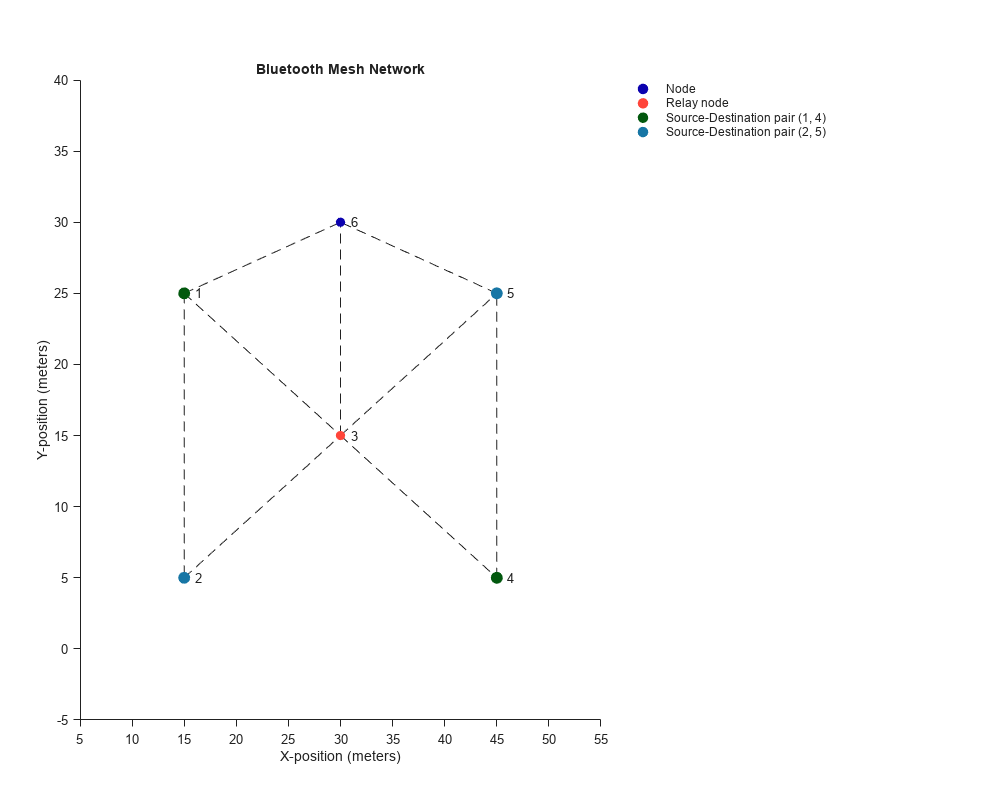Create, Configure, and Visualize Bluetooth Mesh Network
Using this example, you can:
Create a Bluetooth® mesh network by configuring the nodes as source, destination, and relay.
Create and configure Bluetooth mesh profile.
Add On-Off application traffic between the mesh nodes.
Visualize Bluetooth mesh network.
Check if the Communications Toolbox™ Wireless Network Simulation Library support package is installed. If the support package is not installed, MATLAB® returns an error with a link to download and install the support package.
wirelessnetworkSupportPackageCheck;
Specify the total number of Bluetooth LE mesh nodes and their respective positions in the network. This example creates a 6-node Bluetooth mesh network consisting of a relay node, an end node, and two source-destination pairs. For more information about the functionalities of these nodes, see Bluetooth Mesh Networking.
totalNodes = 6;
meshNodesPositions = [15 25; 15 5; 30 15; 45 5; 45 25; 30 30]; % In metersSpecify the relay node and source-destination node pairs. In this example, Node1 and Node2 are source nodes and the corresponding destination nodes are Node4 and Node5.
relayNode = 3; sourceDestinationNodePairs = [1 4; 2 5];
Set the Bluetooth mesh profile configuration parameters. Create Bluetooth mesh nodes with "broadcaster-observer" role.
meshNodes = cell(1,totalNodes); for nodeIdx = 1:totalNodes meshCfg = bluetoothMeshProfileConfig(ElementAddress=dec2hex(nodeIdx,4)); if any(nodeIdx,relayNode) meshCfg.Relay = true; end meshNode = bluetoothLENode("broadcaster-observer", MeshConfig=meshCfg, ... Position=[meshNodesPositions(nodeIdx,:) 0],ReceiverRange=25, ... AdvertisingInterval=20e-3, ScanInterval=30e-3); meshNodes{nodeIdx} = meshNode; end
Add traffic between Node1 - Node4 and Node2 - Node5 source-destination node pairs by using the networkTrafficOnOff object. The networkTrafficOnOff object enables you to create an On-Off application traffic pattern.
% Add traffic between Node1 and Node4 traffic = networkTrafficOnOff(DataRate=1,PacketSize=15,GeneratePacket=true); addTrafficSource(meshNodes{1},traffic, ... SourceAddress=meshNodes{1}.MeshConfig.ElementAddress, ... DestinationAddress=meshNodes{4}.MeshConfig.ElementAddress, ... TTL=3); % Add traffic between Node2 and Node5 traffic = networkTrafficOnOff(DataRate=1,PacketSize=10,GeneratePacket=true); addTrafficSource(meshNodes{2},traffic, ... SourceAddress=meshNodes{2}.MeshConfig.ElementAddress, ... DestinationAddress=meshNodes{5}.MeshConfig.ElementAddress, ... TTL=3);
Visualize the Bluetooth mesh network by using the helperBLEMeshVisualizeNetwork helper function. This helper function displays the created Bluetooth mesh network.
meshNetworkGraph = helperBLEMeshVisualizeNetwork(); % Object for Bluetooth mesh network visualization meshNetworkGraph.NumberOfNodes = totalNodes; % Total number of mesh nodes meshNetworkGraph.NodePositionType = 'UserInput'; % Option to assign node position meshNetworkGraph.Positions = meshNodesPositions; % List of all node positions meshNetworkGraph.ReceiverRange = 25; % Reception range of mesh node meshNetworkGraph.Title = 'Bluetooth Mesh Network'; % Title of plot meshNetworkGraph.SourceDestinationPairs = sourceDestinationNodePairs; % Source-destination node pair meshNetworkGraph.NodeType = [1 1 2 1 1 1]; % State of mesh node meshNetworkGraph.DisplayProgressBar = false; % Display progress bar meshNetworkGraph.createNetwork(); % Display mesh network

References
[1] Bluetooth® Technology Website. “Bluetooth Technology Website | The Official Website of Bluetooth Technology.” Accessed December 25, 2021. https://www.bluetooth.com/.
[2] Bluetooth Special Interest Group (SIG). "Bluetooth Core Specification." Version 5.3. https://www.bluetooth.com/.
[3] Bluetooth Special Interest Group (SIG). "Bluetooth Mesh Profile." Version 1.0.1. https://www.bluetooth.com/.
[4] Bluetooth Special Interest Group (SIG). "Bluetooth Mesh Model Specification." Version 1.0.1. https://www.bluetooth.com/.